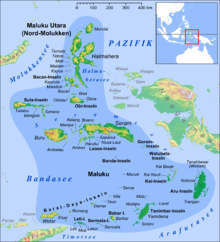Obi paradise crow
| Obi paradise crow | ||||||||||||
|---|---|---|---|---|---|---|---|---|---|---|---|---|

Obi paradise crow ( Lycocorax obiensis ) |
||||||||||||
| Systematics | ||||||||||||
|
||||||||||||
| Scientific name | ||||||||||||
| Lycocorax obiensis | ||||||||||||
| Amber , 1865 |
The obiparadies crow ( Lycocorax obiensis ) is a crow - like- looking bird species from the family of the birds of paradise (Paradisaeidae). It was long considered a subspecies of the bird of paradise of the genus Lycocorax , but is now treated as a separate species. In addition to differences in the plumage, the reason for this was, among other things, a noticeably different behavior of the Obi paradise crows and their clearly different song. The range of the Obiparadiescrahe are the Obi Islands , a group of islands in the Moluccas . The species belongs to the few monogamous species of the birds of paradise.
The IUCN classifies the population of obi paradise crows as safe ( least concern ). There are three subspecies.
description
The Obiparadieskrähe is a medium-sized bird of paradise and reaches a body length of up to 42 centimeters, of which between 13.5 and 15.6 centimeters in the male and between 13 and 15.2 centimeters in the female are tax springs . The beak is 4.5 to 5.4 centimeters in length. The males weigh between 300 and 370 grams, the females are slightly lighter at 250 to 316 grams. The sexes differ only slightly. The females are usually slightly smaller than the males.
The head is glossy black-blue, with the vertex being the darkest. The plumage of the reins and the eyelet is slightly elongated. The over-eye stripe looks as if the obi-paradise crow has strong eyebrows. The coat, the back, the rump and the upper tail-coverts are slightly lighter than the head. Overall, the top of the body is darker than that of the bird of paradise. The upper plumage also shines more intensely. The gloss is blue-black to slightly metallic green. The wings are dark brown, the wing covers have a darker tone, the wing feathers are dark cinnamon brown. The underside of the body is colored like the coat, although the tone on the lower abdomen, rump and tail-coverts is a little more brown. The beak is shiny black, the iris blood red.
Distribution area and habitat

The range of the Obi Paradise crow is limited to the Obi Islands. The Obi Islands are an island group of the Moluccas belonging to Indonesia . They are located in the south of the province of Maluku Utara ("North Moluccas") about halfway between Ternate in the north and the island of Ambon in the south. The main island of Obi is mountainous inland and partly densely forested, the highest point in the center of the island is 1611 meters. The height distribution of the Obiparadiescrahe ranges from the lowlands to altitudes of at least 800 meters. Unlike the closely related bird of paradise, the bird of paradise also inhabits open agricultural land if there are enough bushes.
Way of life
In contrast to the bird of paradise, the bird of paradise is not an inconspicuous, shy and secretly living bird of paradise. Rather, it is considered to be one of the most conspicuous species within the Obi Islands avifauna, which is also noticeable through its loud singing. She lives mostly solitary or in pairs. It is only occasionally found in groups of up to five individuals. The flight is fast and direct and is often interrupted by gliding phases. When flying, a rustling of wings can be heard as an instrumental sound . The diet consists entirely of fruits.
Obi paradise crows are monogamous, both parent birds take care of the rearing of the young birds. The nest is larger compared to the crow's bird of paradise. The few nests found so far were covered with moss on the outside so that they were hardly noticeable unless a brooding bird was sitting in them. One nest was attached to the branch with creepers so that it hung five centimeters below the branch. The clutch consists of a single egg. The duration of the breeding season and the development of the young birds from hatching to escaping have not yet been documented.
literature
- Clifford B. Frith, Bruce M. Beehler : The Birds of Paradise - Paradisaeidae . Oxford University Press, Oxford 1998, ISBN 0-19-854853-2 .
Single receipts
- ↑ Handbook of the Birds of the World on the Crow Paradise Bird , accessed July 4, 2017
- ↑ a b c d Handbook of the Birds of the World on Obiparadieskrähe , accessed on July 5, 2017
- ↑ a b Frith & Beehler: The Birds of Paradise - Paradisaeidae . P. 206
- ↑ Frith & Beehler: The Birds of Paradise - Paradisaeidae . P. 205.
- ↑ Frith & Beehler: The Birds of Paradise - Paradisaeidae . P. 207.
- ↑ a b Frith & Beehler: The Birds of Paradise - Paradisaeidae . P. 208.
- ↑ a b Frith & Beehler: The Birds of Paradise - Paradisaeidae . P. 209.